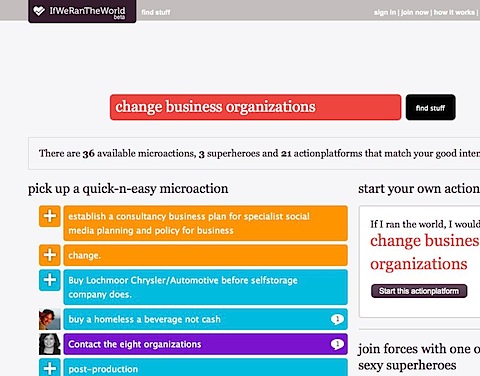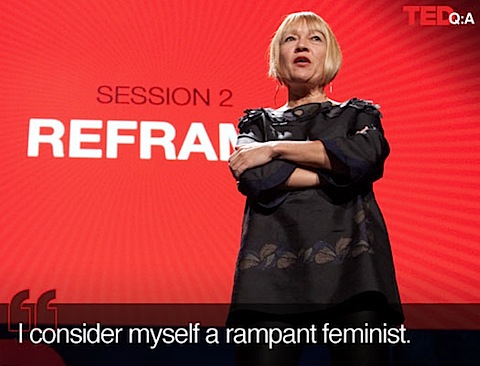If you were building an organization from the ground up, how would you “build authenticity in” from the very start?
I had the chance to ask this question of Cindy Gallop, an entrepreneur and marketing/advertising/branding guru, who is the CEO of a start-up called IfWeRanTheWorld. IfWeRanTheWorld and Cindy have both been recommended to me by several readers who are active in the cause marketing, technology, women who tech, and geek feminism conversations.
IfWeRanTheWorld offers a real-time example of 3 important trends: feminist design principles, designing for authenticity, and designing to create a better world. 
When I wrote about a feminist approach to social network software, and mentioned IfWeRanTheWorld as one live site that is perceived to be built on feminist design principles, Cindy tweeted me and offered to talk about her venture and the software design in more detail. Our conversation was rich and wide ranging, with enough provocative ideas and wise advice to fuel many blog posts. In this post, I want to focus on one small piece, the kind of business organization Cindy and her colleagues have created to organize how they work together.
Innovating From the Very Start
I asked Cindy what it was about IfWeRanTheWorld (IWRTW) that people should notice, that would demonstrate her group’s design philosophy as applied to the business itself and the business operation and structure. She started with the most basic, and most profound, business design principle:
I wanted to innovate in every aspect of how we operated as a business, not just the actual platform itself.
To create the organization that would build this business, make it profitable, and make a difference in the world, Cindy and her team focused on four principles for working together.
1. Design the organization around the kinds of lives the individual members want to live.
Consider the relationship between your members’ work lives and the rest of their lives, and start with a balanced equation. The IWRTW team has made several critical decisions about the design of their business venture together so that they can live the lives they want. When Gallop put a premium on hiring ‘the absolute best’, she also explicitly agreed to find ways that they could work together without asking everyone to choose between moving to NYC or to passing up the opportunity to join IWRTW.
They manage offset time zones and physical distances with all of the tools you might imagine, and they spend money to fly everyone in for important sessions when they need to work together in the same physical space. This arrangement allows each member to work on IWRTW as a start-up while maintaining the personal lives (and the professional connections) that support them in continuing to be their own “absolute best”.
2. Allow, expect and create “the organization” to reflect the authentic voices of the individual members.
Cindy described how, although “IWRTW is built on my own (Cindy’s) DNA”, IWRTW  as an organization is intended to be experienced by the members and others as a composite of the authentic voices of all the the members. IWRTW is as much a creation of Cindy, her values, and her self-expressions as it is the co-creation of the authentic voices of the other members. For example, the occasional off-color tweet or party-boy blog post is absolutely fine when it is a genuine reflection of the member who posted it.
as an organization is intended to be experienced by the members and others as a composite of the authentic voices of all the the members. IWRTW is as much a creation of Cindy, her values, and her self-expressions as it is the co-creation of the authentic voices of the other members. For example, the occasional off-color tweet or party-boy blog post is absolutely fine when it is a genuine reflection of the member who posted it.
There’s little concern that these communications will drive away customers or users– in fact, this kind of authentic communication helps them attract the kinds of users, companies and brands they want to work with, since people who don’t feel comfortable with the identity IWRTW expresses will select themselves out. This is an attitude about the voice of the organization that I describe as “We are all of us being each of us.”
3. Create the kind of organization you want to work in, not something that will make you unhappy, stressed, or depleted.
Inside the organization, find the roles, titles and activities that create the link between who your members are and what they are doing/creating in the organization. Draw on members’ unique (business-relevant) skills and personalities, and support these skills and personalities. A few very basic organizing decisions demonstrate this principle.
First, consider the titles that various members of IWRTW hold. Some examples: Joe Unruh is the Love Agent, Corey Innis is a Code Supervillian, and Rachel Heaton and Julia West are Code Whisperers.
Second, consider the world-changing projects that are unfolding on the beta of their social platform. (I’ll give details about the business itself in another post). As part of demonstrating and developing their product, the members of IWRTW are pursuing their own world-changing goals using their company’s tool. They are putting their software to the test of their own action commitments. They are making sure that their product really can support world-changing initiatives. (See Joe Unruh’s profile for an example.)
4. Design the venture to have a business model that you want, that supports the kind of organization and the kinds of relationships you want.
 This is a bit more complex to tease out, but the idea here is that IWRTW is creating a business — a product and a way of interacting with clients and users — that is literally being the change that they want to see in business itself. Cindy explained how something as straightforward as their pricing model demonstrated their values.
This is a bit more complex to tease out, but the idea here is that IWRTW is creating a business — a product and a way of interacting with clients and users — that is literally being the change that they want to see in business itself. Cindy explained how something as straightforward as their pricing model demonstrated their values.
Our product is designed to be affordable to the kinds of businesses we want to support. Running an ad agency (Cindy’s previous business), we had complicated compensations agreements that were different with each different client. At IWRTW, our pricing policy is transparent and simple. It makes it easy for us to do business, and to do business fairly.
Is this model of a tech start-up “competitive”?
As Cindy and I talked about the model of the authentic organization that they are creating in the start-up of IWRTW, I noted the many ways that their organization and their business model are ‘different’ from what we expect to see at the typical tech start-up (e.g., folks sleeping under their desks, a 24 hour work day, founders desperate to look serious and to impress investors.)
I had to ask Cindy whether she was ever concerned that their venture might not seem dedicated or competitive enough to potential funders or to potential clients. Cindy replied:
That’s fabulous, actually, not to look like other start-ups, because you make your client base very self-selecting. When you define yourselves very clearly in terms of what you stand for, that makes everything in your business life so much easier. You attract to your business the people you want to work with, and the people you want to work for. You engage the ways you want to, and with whom you want to.
It ends up being a fabulous business discriminator. … If you only ever behave, act and communicate in ways that are true to you and the venture, the more ways you can demonstrate who you are with everything you do. You never have to worry about how you come across to people, because you never act in ways that you would feel ashamed of.
This is liberating, in every piece of the business.
You can see this liberation, and the alignment between their purpose, their identity and their everyday actions, just in this self-description of IfWeRanTheWorld:
IfWeRanTheWorld is a real-world experiment in tapping good intentions and turning them into tangible, do-able microactions that anyone and everyone can help you to do. All of us can achieve more than one of us, and everything starts with a microaction.
Being authentic as an organization starts with deliberate choices — some big, some small, and some micro.
From the very start-up, designing your organization to demonstrate the power of your product, and to demonstrate the power of your business purpose, builds a foundation for ongoing authenticity with clients, with each other, and together. 
See also: Yes, We Plan: How Altruism and Advertising Could Change the World, in Wired, by Elliot Van Buskirk
Facebook for Women vs. Facebook Designed by Feminists: Different vs. Revolutionary
If Women Had Designed Facebook
Authentic Student Entrepreneurs: Embedding Personal, Product and Organizational Brand
Image from TED Blog
 I am an organizational consultant, change advocate, and organizational identity/reputation scholar with a PhD in leadership & organizations. I research, write about, and consult with organizations on the relationships between organizational identity, actions, and purpose. I teach Technology Management, part-time, at Stevens Institute of Technology.
My current research focuses on how social technologies in the workplace can drive organizational change, generate meaning, and catalyze purpose. See the
I am an organizational consultant, change advocate, and organizational identity/reputation scholar with a PhD in leadership & organizations. I research, write about, and consult with organizations on the relationships between organizational identity, actions, and purpose. I teach Technology Management, part-time, at Stevens Institute of Technology.
My current research focuses on how social technologies in the workplace can drive organizational change, generate meaning, and catalyze purpose. See the 
Comments on this entry are closed.
{ 2 trackbacks }